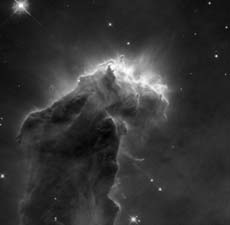Return to Index |
Previous Image |
Next Image |
The Eagle Nebula, or M16, is 7,000 light
years from Earth in the constellation Serpens. It is composed of dark
columns of cool, dark clouds of gas and dust. These clouds consist primarily
of hydrogen, although there are also a few carbon and silicate particles
present, similar to those found in terrestrial rocks. Because these molecules
are so dense, they have survived longer than their surrounding environment
as they have been bombarded by the ultraviolet light emitted by hot, massive
young stars. This light also illuminates the surface of the gaseous columns,
highlighting the three dimensional beauty of the structures. The tallest
of the pillars is about one light year long from top to bottom. The ultraviolet
light slowly erodes the pillars, replacing them with globules of denser
gas. These globules, buried well within the pillars, are known by the
acronym EGGs (Evaporating Gaseous Globules). This name suits the structure
well, because these globules serve as the embryos for newborn stars, many
of which are much more massive than our Sun. Although the nebula itself
will disappear with time, it will leave behind a multitude of stars that
will join the rest of our Galaxy. (Courtesy of NASA's Hubble
Space Telescope.)
References:
http://seds.lpl.arizona.edu:80/billa/twn/n6611x.html
Object |
Distance from Earth |
Wavelength |
Eagle Nebula |
7,000
light years |
Optical |

